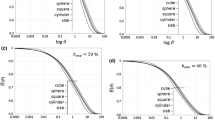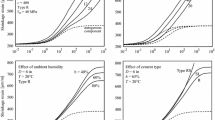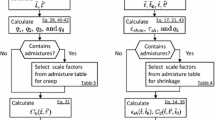Abstract
The restraint of drying, autogenous, or thermal shrinkage can result in the development of tensile residual stresses. If the residual stresses that develop are large enough, they may cause cracking in the concrete. Substantial research has focused on the development of test methods to assess stress development and the corresponding potential for cracking. These test methods frequently focus on the determination of material properties that can be used in deterministic computer programs to simulate stress development and cracking. While these models are a great step forward, variability is inherent in the material properties, the construction processes, and the environmental conditions (i.e., temperature and relative humidity). This paper presents results of considering variability in a model for predicting the time of shrinkage cracking. A Monte Carlo simulation procedure has been adopted to account for variability in material properties. It has been found that a log-logistic function can accurately describe variability that can be expected in the time of cracking.
Similar content being viewed by others
References
Weiss WJ (1997) Shrinkage cracking in restrained concrete slabs: Test Methods, Material Compositions, Shrinkage Reducing Admixtures and Theoretical Modeling, MS Dissertation (Northwestern University, Evanston, IL)
Weiss WJ (1999) Prediction of Early-Age Shrinkage Cracking in Concrete Elements, Ph.D. Dissertation (Northwestern University, Evanston, IL)
Shah SP, Weiss WJ, Yang W (1998) Shrinkage cracking – can it be prevented?, Concrete International 20(4):51–55
Schindler AK, Ruiz JM, Rasmussen RO, Chang GK, Wathne LG (2004)Concrete pavement temperature prediction and case studies with the FHWA HIPERPAV models, Cement and Concrete Composites 26(5):463–471
Schlangen, HEJG, Koenders, EAB van Breugel K (2004) Multi-scale modelling of crack formation in the concrete cover zone, Advances in Cement and Concrete, Engineering Conferences International, In: Lange DA, Scrivener KL, Marchand J (eds) (Illinios at Urbana-Champaign):281–291
Parameswaran S (2004) Investigating the Role of Material Properties and Their Variability in the Selection of Repair Materials, MS Dissertation (Purdue University, West Lafayette, IN)
Weiss WJ, Shah SP (March 2001) Restrained shrinkage cracking: the role of shrinkage reducing admixtures and specimen geometry. In: Kovler K, Bentur A (eds) RILEM International Conference on Early-Age Cracking in Cementitious Systems (EAC'01), Haifa, Israel:145–158
Moon JH, Rajabipour F, Weiss WJ (June 2004) Incorporating moisture diffusion in the analysis of the restrained ring test. In: Sakai K, Gjorv OE, Banthia N (eds) Proceedings of the 4th International Conference on Concrete Under Severe Conditions: Environment & Loading (CONSEC), Vol. 2, Seoul, Korea: 1973–1980
Moon JH, Rajabipour F, Pease B, Weiss WJ (June 2005) Autogenous shrinkage, residual stress, and cracking in cementitious composites: The influence of internal and external restraint., In: Fourth International Seminar on Self-desiccation and Its Importance in Concrete Technology. National Institute of Standard and Technology, Gaithersburg, Maryland:1–20
McIntosh JD (1956) The effects of low-temperature curing on the compressive strength of concrete. In: Proceedings of the RILEM Symposium on Winter Concreting. Copenhagen
Bjontegaard O (1999) Thermal Dilation and Autogenous Deformation as Driving Forces to Self-Induced Stresses in High Performance Concrete, Ph.D. Dissertation (NTNU, Trondheim)
Olken P, Rostasy FS (1994)A practical planning tool for the simulation of thermal stresses and for the prediction of early thermal cracks in massive concrete structures. In: Springenschmid R (eds) Thermal Cracking in Concrete At Early-Ages. (E & FN Spon, London):289–296
Barde A (2004)Early Age Flexural Behaviour of Cementitious Systems and Factors Affecting Maturity Based Predictions, MS Dissertation (Purdue University, West Lafayette, IN)
Bazant ZP (1989) Mathematical Modelling of Creep and Shrinkage of Concrete, (John Wiley & Sons, Hoboken, NJ)
Muller HS (1992) New Prediction Models for Creep and Shrinkage of Concrete. In: Daye MA, Fu CC (eds) Creep and Shrinkage of Concrete: Effect of Materials and Environment. (American Concrete Institute, Detroit, MI)
Pease BJ (2005) The Role of Shrinkage Reducing Admixtures on Shrinkage, Stress Development, and Cracking, MS Dissertation (Purdue University, West Lafayette, IN)
Pickett G (1956) Effect of aggregate on shrinkage of concrete and hypothesis concerning shrinkage. Journal of the American Concrete Institute 52:581–590
L Hermite, RG (1960) Volume changes of concrete. In: Fourth International Symposium on the Chemistry of Cement Washington, DC:659–694
Pease BJ, Shah HR, Weiss WJ (2005) Shrinkage behaviour and residual stress development in mortars containing shrinkage reducing admixtures (SRAs). In: Gardner NJ, Weiss WJ (eds) ACI SP 227 - Shrinkage and Creep of Concrete. (American Concrete Institute, Detroit, MI)
Weiss WJ, Borischevsky BB, Shah SP (1999) The influence of a shrinkage reducing admixture on the early-age behaviour of high performance concrete. In: Fifth International Symposium on the Utilization of High Strength/High Performance Concrete. Vol. 2 (Sandefjord, Norway):1418–1428
Osterle RG, Refai TM, Weiss WJ (1994) Variations in calculated movements of jointless bridges using Monte Carlo simulation. Construction Technologies Laboratories Report, Skokie, IL
Day K (1999) Concrete Mix Design, Quality Control and Specification, 2nd Edn. (E & FN Spon, London)
Author information
Authors and Affiliations
Rights and permissions
About this article
Cite this article
Radlinska, A., Pease, B. & Weiss, J. A preliminary numerical investigation on the influence of material variability in the early-age cracking behavior of restrained concrete. Mater Struct 40, 375–386 (2007). https://doi.org/10.1617/s11527-006-9118-8
Accepted:
Published:
Issue Date:
DOI: https://doi.org/10.1617/s11527-006-9118-8




